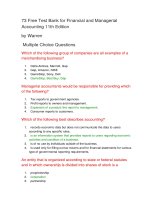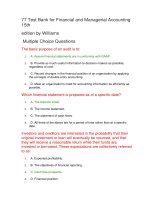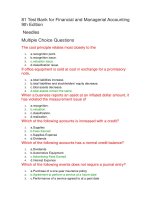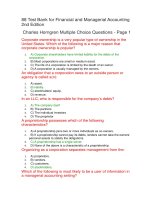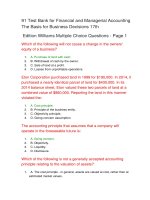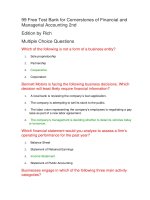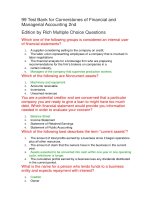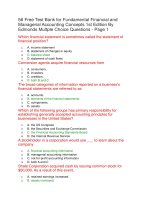Test bank financial and managerial accounting by warren 9e ch20(5) variable costing for management analysis
Bạn đang xem bản rút gọn của tài liệu. Xem và tải ngay bản đầy đủ của tài liệu tại đây (144.84 KB, 40 trang )
Chapter 20(5)
Variable Costing For Management Analysis
OBJECTIVES
Obj1
Obj 2
Obj 3
Obj 4
Obj 5
Obj 6
Describe and illustrate income reporting under variable costing and absorption
costing.
Describe and illustrate income analysis under variable costing and absorption
costing.
Describe and illustrate management’s use of variable costing and absorption costing
for controlling costs, pricing products, planning production, analyzing contribution
margins, and analyzing market segments.
Use variable costing for analyzing market segments including product, territories,
and salespersons segments.
Use variable costing for analyzing and explaining changes in contribution margin as
a result of quantity and price factors.
Describe and illustrate the use of variable costing for service firms.
QUESTION GRID
True/False
No.
1
2
3
4
5
6
7
8
9
10
11
12
13
14
15
16
17
18
19
20
21
22
Objective
20(5)-01
20(5)-01
20(5)-01
20(5)-01
20(5)-01
20(5)-01
20(5)-01
20(5)-01
20(5)-01
20(5)-01
20(5)-01
20(5)-01
20(5)-01
20(5)-01
20(5)-01
20(5)-01
20(5)-01
20(5)-01
20(5)-01
20(5)-01
20(5)-01
20(5)-01
1
2 ✦ Chapter 20(5)/Variable Costing For Management Analysis
Multiple Choice
No.
Objective
1
2
3
4
5
6
7
8
9
10
11
12
13
14
15
16
17
18
19
20
21
22
23
24
20(5)-01
20(5)-01
20(5)-01
20(5)-01
20(5)-01
20(5)-01
20(5)-01
20(5)-01
20(5)-01
20(5)-01
20(5)-01
20(5)-01
20(5)-01
20(5)-01
20(5)-01
20(5)-01
20(5)-01
20(5)-02
20(5)-02
20(5)-02
20(5)-02
20(5)-02
20(5)-02
20(5)-02
Exercise/Other
N Obj Diffi
o ecti culty
. ve
1 20(5 Mod
)-01 erate
N Object
o
ive
.
5 20(5)01
2 20(5
)-01
Mod
erate
6 20(5)01
3 20(5
)-01
Mod
erate
7 20(5)02
4 20(5
)-01
Mod
erate
8 20(5)02
Diff
icul
ty
Mo
dera
te
Mo
dera
te
Mo
dera
te
Mo
dera
te
N
o
.
9
Obj
ecti
ve
20(5
)-04
Diff
icul
ty
Diff
icult
1 20(5
0 )-05
Diff
icult
Chapter 20(5)/Variable Costing For Management Analysis ✦ 3
Problem
N Obj
o ecti
. ve
1 20(5
)-01
Diffi
culty
Diffi
cult
N Object
o
ive
.
4 20(5)02
Diff
icul
ty
Mo
dera
te
2 20(5
)-01
Diffi
cult
5 20(5)03
3 20(5
)-02
Easy
6 20(5)03
Mo
dera
te
Diff
icult
N
o
.
7
Obj
ecti
ve
20(5
)04,
06
Diff
icul
ty
Diff
icult
Chapter 20(5)—Variable Costing For Management Analysis
TRUE/FALSE
1.
In determining cost of goods sold, two alternate costing concepts can be used: absorption
costing and variable costing.
ANS: T
DIF: Easy OBJ: 20(5)-01
NAT: AACSB Analytic | IMA-Cost Management
2.
In determining cost of goods sold, two alternate costing concepts can be used: direct costing
and variable costing.
ANS: F
DIF: Easy OBJ: 20(5)-01
NAT: AACSB Analytic | IMA-Cost Management
3.
Fixed factory overhead costs are included as part of the cost of products manufactured under
the absorption costing concept.
ANS: T
DIF: Easy OBJ: 20(5)-01
NAT: AACSB Analytic | IMA-Cost Management
4.
Under absorption costing, the cost of finished goods includes direct materials, direct labor,
and factory overhead.
ANS: T
DIF: Easy OBJ: 20(5)-01
NAT: AACSB Analytic | IMA-Cost Management
5.
Under absorption costing, the cost of finished goods includes only direct materials, direct
labor, and variable factory overhead.
ANS: F
DIF: Easy OBJ: 20(5)-01
NAT: AACSB Analytic | IMA-Cost Management
4 ✦ Chapter 20(5)/Variable Costing For Management Analysis
6.
In variable costing, the cost of products manufactured is composed of only those
manufacturing costs that increase or decrease as the volume of production rises or falls.
ANS: T
DIF: Easy OBJ: 20(5)-01
NAT: AACSB Analytic | IMA-Cost Management
7.
In variable costing, fixed costs do not become part of the cost of goods manufactured, but
are considered an expense of the period.
ANS: T
DIF: Easy OBJ: 20(5)-01
NAT: AACSB Analytic | IMA-Cost Management
8. Variable costing is also known as direct costing.
ANS: T
DIF: Easy OBJ: 20(5)-01
NAT: AACSB Analytic | IMA-Cost Management
9.
Property taxes on a factory building would be included as part of the cost of products
manufactured under the absorption costing concept.
ANS: T
DIF: Difficult
OBJ: 20(5)-01
NAT: AACSB Analytic | IMA-Cost Management
10. The factory superintendent's salary would be included as part of the cost of products
manufactured under the variable costing concept.
ANS: F
DIF: Difficult
OBJ: 20(5)-01
NAT: AACSB Analytic | IMA-Cost Management
11. The factory superintendent's salary would be included as part of the cost of products
manufactured under the absorption costing concept.
ANS: T
DIF: Difficult
OBJ: 20(5)-01
NAT: AACSB Analytic | IMA-Cost Management
12. Electricity purchased to operate factory machinery would be included as part of the cost of
products manufactured under the absorption costing concept.
ANS: T
DIF: Difficult
OBJ: 20(5)-01
NAT: AACSB Analytic | IMA-Cost Management
13. The absorption costing income statement does not distinguish between variable and fixed
costs.
ANS: T
DIF: Easy OBJ: 20(5)-01
NAT: AACSB Analytic | IMA-Cost Management
14. In the absorption costing income statement, deduction of the cost of goods sold from sales
yields gross profit.
ANS: T
DIF: Easy OBJ: 20(5)-01
NAT: AACSB Analytic | IMA-Cost Management
Chapter 20(5)/Variable Costing For Management Analysis ✦ 5
15. In the absorption costing income statement, deduction of the cost of goods sold from sales
yields contribution margin.
ANS: F
DIF: Easy OBJ: 20(5)-01
NAT: AACSB Analytic | IMA-Cost Management
16. In the absorption costing income statement, deduction of the cost of goods sold from sales
yields manufacturing margin.
ANS: F
DIF: Easy OBJ: 20(5)-01
NAT: AACSB Analytic | IMA-Cost Management
17. On the variable costing income statement, deduction of the variable cost of goods sold from
sales yields gross profit.
ANS: F
DIF: Easy OBJ: 20(5)-01
NAT: AACSB Analytic | IMA-Cost Management
18. On the variable costing income statement, deduction of the variable cost of goods sold from
sales yields manufacturing margin.
ANS: T
DIF: Easy OBJ: 20(5)-01
NAT: AACSB Analytic | IMA-Cost Management
19. On the variable costing income statement, all of the fixed costs are deducted from the
contribution margin.
ANS: T
DIF: Easy OBJ: 20(5)-01
NAT: AACSB Analytic | IMA-Cost Management
20. On the variable costing income statement, variable selling and administrative expenses are
deducted from manufacturing margin to yield contribution margin.
ANS: T
DIF: Easy OBJ: 20(5)-01
NAT: AACSB Analytic | IMA-Cost Management
21. On the variable costing income statement, variable costs are deducted from contribution
margin to yield manufacturing margin.
ANS: F
DIF: Easy OBJ: 20(5)-01
NAT: AACSB Analytic | IMA-Cost Management
22. On the variable costing income statement, the figure representing the difference between the
contribution margin and income from operations is the fixed manufacturing costs and fixed
selling and administrative expenses.
ANS: T
DIF: Easy OBJ: 20(5)-01
NAT: AACSB Analytic | IMA-Cost Management
23. The contribution margin and the manufacturing margin are usually equal.
ANS: F
DIF: Difficult
OBJ: 20(5)-01
NAT: AACSB Analytic | IMA-Cost Management
6 ✦ Chapter 20(5)/Variable Costing For Management Analysis
24. For a period during which the quantity of inventory at the end was larger than that at the
beginning, income from operations reported under variable costing will be larger than
income from operations reported under absorption costing.
ANS: F
DIF: Difficult
OBJ: 20(5)-01
NAT: AACSB Analytic | IMA-Cost Management
25. For a period during which the quantity of inventory at the end was larger than that at the
beginning, income from operations reported under variable costing will be smaller than
income from operations reported under absorption costing.
ANS: T
DIF: Difficult
OBJ: 20(5)-01
NAT: AACSB Analytic | IMA-Cost Management
26. For a period during which the quantity of inventory at the end was smaller than that at the
beginning, income from operations reported under variable costing will be larger than
income from operations reported under absorption costing.
ANS: T
DIF: Difficult
OBJ: 20(5)-01
NAT: AACSB Analytic | IMA-Cost Management
27. For a period during which the quantity of inventory at the end was smaller than that at the
beginning, income from operations reported under variable costing will be smaller than
income from operations reported under absorption costing.
ANS: F
DIF: Difficult
OBJ: 20(5)-01
NAT: AACSB Analytic | IMA-Cost Management
28. For a period during which the quantity of inventory at the end equals the inventory at the
beginning, income from operations reported under variable costing will be smaller than
income from operations reported under absorption costing.
ANS: F
DIF: Difficult
OBJ: 20(5)-01
NAT: AACSB Analytic | IMA-Cost Management
29. For a period during which the quantity of inventory at the end equals the inventory at the
beginning, income from operations reported under variable costing will equal income from
operations reported under absorption costing.
ANS: T
DIF: Difficult
OBJ: 20(5)-01
NAT: AACSB Analytic | IMA-Cost Management
30. For a period during which the quantity of product manufactured exceeded the quantity sold,
income from operations reported under absorption costing will be smaller than income from
operations reported under variable costing.
ANS: F
DIF: Difficult
OBJ: 20(5)-01
NAT: AACSB Analytic | IMA-Cost Management
Chapter 20(5)/Variable Costing For Management Analysis ✦ 7
31. For a period during which the quantity of product manufactured exceeded the quantity sold,
income from operations reported under absorption costing will be larger than income from
operations reported under variable costing.
ANS: T
DIF: Difficult
OBJ: 20(5)-01
NAT: AACSB Analytic | IMA-Cost Management
32. For a period during which the quantity of product manufactured was less than the quantity
sold, income from operations reported under absorption costing will be larger than income
from operations reported under variable costing.
ANS: F
DIF: Difficult
OBJ: 20(5)-01
NAT: AACSB Analytic | IMA-Cost Management
33. For a period during which the quantity of product manufactured was less than the quantity
sold, income from operations reported under absorption costing will be smaller than income
from operations reported under variable costing.
ANS: T
DIF: Difficult
OBJ: 20(5)-01
NAT: AACSB Analytic | IMA-Cost Management
34. For a period during which the quantity of product manufactured equals the quantity sold,
income from operations reported under absorption costing will equal the income from
operations reported under variable costing.
ANS: T
DIF: Difficult
OBJ: 20(5)-01
NAT: AACSB Analytic | IMA-Cost Management
35. For a period during which the quantity of product manufactured equals the quantity sold,
income from operations reported under absorption costing will be smaller than the income
from operations reported under variable costing.
ANS: F
DIF: Difficult
OBJ: 20(5)-01
NAT: AACSB Analytic | IMA-Cost Management
36. Changes in the quantity of finished goods inventory, caused by differences in the levels of
sales and production, directly affects the amount of income from operations reported under
absorption costing.
ANS: T
DIF: Difficult
OBJ: 20(5)-02
NAT: AACSB Analytic | IMA-Cost Management
37. Under absorption costing, the amount of income reported from operations can be increased
by producing more units than are sold.
ANS: T
DIF: Difficult
OBJ: 20(5)-02
NAT: AACSB Analytic | IMA-Cost Management
38. Under absorption costing, increases or decreases in income from operations due to changes
in inventory levels could be misinterpreted to be the result of operating efficiencies or
inefficiencies.
ANS: T
DIF: Difficult
OBJ: 20(5)-02
NAT: AACSB Analytic | IMA-Cost Management
8 ✦ Chapter 20(5)/Variable Costing For Management Analysis
39. Management may use both absorption and variable costing methods for analyzing a
particular product.
ANS: T
DIF: Difficult
OBJ: 20(5)-03
NAT: AACSB Analytic | IMA-Cost Management
40. Property tax expense is an example of a controllable cost for the supervisor of a
manufacturing department.
ANS: F
DIF: Difficult
OBJ: 20(5)-03
NAT: AACSB Analytic | IMA-Cost Management
41. Direct labor cost is an example of a controllable cost for the supervisor of a manufacturing
department.
ANS: T
DIF: Difficult
OBJ: 20(5)-03
NAT: AACSB Analytic | IMA-Cost Management
42. In the short run, the selling price of a product should normally not be less than the variable
costs and expenses of making and selling it.
ANS: T
DIF: Easy OBJ: 20(5)-03
NAT: AACSB Analytic | IMA-Cost Management
43. In the long run, for a business to remain in operation, the selling price of a product should
normally cover all costs and expenses and provide a reasonable income.
ANS: T
DIF: Easy OBJ: 20(5)-03
NAT: AACSB Analytic | IMA-Cost Management
44. For short-run production planning, information in the variable costing format is more useful
to management than is information in the absorption costing concept format.
ANS: T
DIF: Easy OBJ: 20(5)-03
NAT: AACSB Analytic | IMA-Cost Management
45. For short-run production planning, information in the absorption costing format is more
useful to management than is information in the variable costing format.
ANS: F
DIF: Easy OBJ: 20(5)-03
NAT: AACSB Analytic | IMA-Cost Management
46. Sales mix is generally defined as the relative distribution of sales among the various
products sold.
ANS: T
DIF: Easy OBJ: 20(5)-04
NAT: AACSB Analytic | IMA-Performance Measurement
47. If the ability to sell and the amount of production facilities devoted to each of two products
is equal, it is profitable to increase the sales of that product with the lowest contribution
margin.
ANS: F
DIF: Difficult
OBJ: 20(5)-04
NAT: AACSB Analytic | IMA-Performance Measurement
Chapter 20(5)/Variable Costing For Management Analysis ✦ 9
48. If the ability to sell and the amount of production facilities devoted to each of two products
is equal, it is profitable to increase the sales of that product with the highest contribution
margin.
ANS: T
DIF: Difficult
OBJ: 20(5)-04
NAT: AACSB Analytic | IMA-Performance Measurement
49. The contribution margin ratio is computed as contribution margin divided by sales.
ANS: T
DIF: Easy OBJ: 20(5)-04
NAT: AACSB Analytic | IMA-Performance Measurement
50. In evaluating the performance of salespersons, the salesperson with the highest level of sales
should be evaluated as the best performer.
ANS: F
DIF: Difficult
OBJ: 20(5)-04
NAT: AACSB Analytic | IMA-Performance Measurement
51. Companies prepare contribution margin reports by market segments and product segments
because products contribute to profitability in various ways.
ANS: T
DIF: Easy OBJ: 20(5)-04
NAT: AACSB Analytic | IMA-Performance Measurement
52. Ford’s Expedition sport utility vehicle is its most profitable model. Therefore Ford should
increase production levels and promotional efforts on its other models to increase their sales.
ANS: F
DIF: Easy OBJ: 20(5)-04
NAT: AACSB Analytic | IMA-Performance Measurement
53. The systematic examination of differences between planned and actual contribution margins
is termed contribution margin analysis.
ANS: T
DIF: Easy OBJ: 20(5)-05
NAT: AACSB Analytic | IMA-Performance Measurement
54. In contribution margin analysis, the effect of a difference in the number of units sold,
assuming no change in unit sales price or cost, is termed the quantity factor.
ANS: T
DIF: Easy OBJ: 20(5)-05
NAT: AACSB Analytic | IMA-Performance Measurement
55. In contribution margin analysis, the effect of a difference in the number of units sold,
assuming no change in unit sales price or cost, is termed the unit price or unit cost factor.
ANS: F
DIF: Easy OBJ: 20(5)-05
NAT: AACSB Analytic | IMA-Performance Measurement
56. In contribution margin analysis, the effect of a difference in unit sales price or unit cost on
the number of units sold is termed the unit price or unit cost factor.
ANS: T
DIF: Easy OBJ: 20(5)-05
NAT: AACSB Analytic | IMA-Performance Measurement
10 ✦ Chapter 20(5)/Variable Costing For Management Analysis
57. In contribution margin analysis, the effect of a difference in unit sales price or unit cost on
the number of units sold is termed the quantity factor.
ANS: F
DIF: Easy OBJ: 20(5)-05
NAT: AACSB Analytic | IMA-Performance Measurement
58. In contribution margin analysis, the quantity factor is computed as the difference between
actual quantity sold and the planned quantity sold, multiplied by the planned unit sales price
or unit cost.
ANS: T
DIF: Easy OBJ: 20(5)-05
NAT: AACSB Analytic | IMA-Performance Measurement
59. In contribution margin analysis, the unit price or unit cost factor is computed as the
difference between actual quantity sold and the planned quantity sold, multiplied by the
planned unit sales price or unit cost.
ANS: F
DIF: Easy OBJ: 20(5)-05
NAT: AACSB Analytic | IMA-Performance Measurement
60. In contribution margin analysis, the unit price or unit cost factor is computed as the
difference between the actual unit price or unit cost and the planned unit price or unit cost,
multiplied by the actual quantity sold.
ANS: T
DIF: Easy OBJ: 20(5)-05
NAT: AACSB Analytic | IMA-Performance Measurement
61. A change in the amount of sales can be due to either a change in the units sold or a change in
price or both.
ANS: T
DIF: Difficult
OBJ: 20(5)-05
NAT: AACSB Analytic | IMA-Performance Measurement
62. Contribution margin reporting and analysis is appropriate only for manufacturing firms, not
for service firms.
ANS: F
DIF: Moderate
OBJ: 20(5)-06
NAT: AACSB Analytic | IMA-Performance Measurement
63. Service firms can only have one activity base for analyzing changes in costs.
ANS: F
DIF: Moderate
OBJ: 20(5)-06
NAT: AACSB Analytic | IMA-Performance Measurement
64. In a service firm it may be necessary to have several activity bases to properly match the
change in costs with the changes in various activities.
ANS: T
DIF: Moderate
OBJ: 20(5)-06
NAT: AACSB Analytic | IMA-Performance Measurement
Chapter 20(5)/Variable Costing For Management Analysis ✦ 11
65. Service firms are unable to use contribution margin report and analysis in their company
because these firms do not sell inventory.
ANS: F
DIF: Easy OBJ: 20(5)-06
NAT: AACSB Analytic | IMA-Performance Measurement
MULTIPLE CHOICE
1.
What term is commonly used to describe the concept whereby the cost of manufactured
products is composed of direct materials cost, direct labor cost, and factory overhead cost?
a. Standard costing
b. Variable costing
c. Absorption costing
d. Direct costing
ANS: C
DIF: Easy OBJ: 20(5)-01
NAT: AACSB Analytic | IMA-Cost Management
2.
What term is commonly used to describe the concept whereby the cost of manufactured
products is composed of direct materials cost, direct labor cost, and variable factory
overhead cost?
a. Absorption costing
b. Differential costing
c. Standard costing
d. Variable costing
ANS: D
DIF: Easy OBJ: 20(5)-01
NAT: AACSB Analytic | IMA-Cost Management
3.
Another name for variable costing is:
a. indirect costing
b. process costing
c. direct costing
d. differential costing
ANS: C
DIF: Easy OBJ: 20(5)-01
NAT: AACSB Analytic | IMA-Cost Management
4.
Under absorption costing, which of the following costs would not be included in finished
goods inventory?
a. Direct labor cost
b. Direct materials cost
c. Variable and fixed factory overhead cost
d. Variable and fixed selling and administrative expenses
ANS: D
DIF: Easy OBJ: 20(5)-01
NAT: AACSB Analytic | IMA-Cost Management
12 ✦ Chapter 20(5)/Variable Costing For Management Analysis
5.
Under absorption costing, which of the following costs would not be included in finished
goods inventory?
a. Hourly wages of assembly worker
b. Straight-line depreciation on factory equipment
c. Overtime wages paid factory workers
d. Advertising costs for a furniture manufacturer
ANS: D
DIF: Difficult
OBJ: 20(5)-01
NAT: AACSB Analytic | IMA-Cost Management
6.
Under variable costing, which of the following costs would not be included in finished
goods inventory?
a. Direct labor cost
b. Direct materials cost
c. Variable factory overhead cost
d. Fixed factory overhead cost
ANS: D
DIF: Easy OBJ: 20(5)-01
NAT: AACSB Analytic | IMA-Cost Management
7.
Under variable costing, which of the following costs would be included in finished goods
inventory?
a. Selling costs
b. Salary of vice-president of finance
c. Variable factory overhead cost
d. Fixed factory overhead cost
ANS: C
DIF: Difficult
OBJ: 20(5)-01
NAT: AACSB Analytic | IMA-Cost Management
8.
Under variable costing, which of the following costs would be included in finished goods
inventory?
a. Advertising costs
b. Salary of vice-president of finance
c. Wages of carpenters in a furniture factory
d. Straight-line depreciation on factory equipment
ANS: C
DIF: Difficult
OBJ: 20(5)-01
NAT: AACSB Analytic | IMA-Cost Management
9.
Under variable costing, which of the following costs would not be included in finished
goods inventory?
a. Wages of machine operator
b. Steel costs for a machine tool manufacturer
c. Salary of factory supervisor
d. Oil costs used to lubricate machinery
ANS: C
DIF: Difficult
OBJ: 20(5)-01
NAT: AACSB Analytic | IMA-Cost Management
Chapter 20(5)/Variable Costing For Management Analysis ✦ 13
10. Which of the following would be included in the cost of a product manufactured according
to absorption costing?
a. Advertising expense
b. Sales salaries
c. double declining balance depreciation expense on factory building
d. Office supplies costs
ANS: C
DIF: Difficult
OBJ: 20(5)-01
NAT: AACSB Analytic | IMA-Cost Management
11. Which of the following would be included in the cost of a product manufactured according
to variable costing?
a. Sales commissions
b. Property taxes on factory buildings
c. Interest expense
d. Direct materials
ANS: D
DIF: Difficult
OBJ: 20(5)-01
NAT: AACSB Analytic | IMA-Cost Management
12. On the variable costing income statement, the figure representing the difference between
manufacturing margin and contribution margin is the:
a. fixed manufacturing costs
b. variable cost of goods sold
c. fixed selling and administrative expenses
d. variable selling and administrative expenses
ANS: D
DIF: Easy OBJ: 20(5)-01
NAT: AACSB Analytic | IMA-Cost Management
13. In the variable costing income statement, deduction of variable selling and administrative
expenses from manufacturing margin yields:
a. differential margin
b. contribution margin
c. gross profit
d. marginal expenses
ANS: B
DIF: Easy OBJ: 20(5)-01
NAT: AACSB Analytic | IMA-Cost Management
14. The amount of income under absorption costing will equal the amount of income under
variable costing when units manufactured:
a. exceed units sold
b. equal units sold
c. are less than units sold
d. are equal to or greater than units sold
ANS: B
DIF: Difficult
OBJ: 20(5)-01
NAT: AACSB Analytic | IMA-Cost Management
14 ✦ Chapter 20(5)/Variable Costing For Management Analysis
15. The amount of income under absorption costing will be less than the amount of income
under variable costing when units manufactured:
a. exceed units sold
b. equal units sold
c. are less than units sold
d. are equal to or greater than units sold
ANS: C
DIF: Difficult
OBJ: 20(5)-01
NAT: AACSB Analytic | IMA-Cost Management
16. Which of the following statements is correct using the direct costing concept?
a. All manufacturing costs are included in the calculation of cost of goods manufactured
b. Only fixed costs are included in the calculation of cost of goods manufactured while
variable costs are considered period costs.
c. Only variable costs are included in the calculation of cost of goods manufactured while
fixed costs are considered period costs.
d. All manufacturing costs are considered period costs.
ANS: C
DIF: Moderate
OBJ: 20(5)-01
NAT: AACSB Analytic | IMA-Cost Management
17. The amount of income under absorption costing will be more than the amount of income
under variable costing when units manufactured:
a. exceed units sold
b. equal units sold
c. are less than units sold
d. are equal to or greater than units sold
ANS: A
DIF: Difficult
OBJ: 20(5)-01
NAT: AACSB Analytic | IMA-Cost Management
18. The level of inventory of a manufactured product has increased by 8,000 units during a
period. The following data are also available:
Unit manufacturing costs of the period
Unit operating expenses of the period
Variable
$12.00
4.00
Fixed
$5.00
1.50
What would be the effect on income from operations if absorption costing is used rather than
variable costing?
a. $40,000 decrease
b. $40,000 increase
c. $44,000 increase
d. $52,000 increase
ANS: B
DIF: Moderate
OBJ: 20(5)-02
NAT: AACSB Analytic | IMA-Cost Management
Chapter 20(5)/Variable Costing For Management Analysis ✦ 15
19. The level of inventory of a manufactured product has increased by 8,000 units during a
period. The following data are also available:
Unit manufacturing costs of the period
Unit operating expenses of the period
Variable
$24
8
Fixed
$10
3
What would be the effect on income from operations if variable costing is used rather than
absorption costing?
a. $80,000 decrease
b. $80,000 increase
c. $88,000 increase
d. $104,000 increase
ANS: A
DIF: Moderate
OBJ: 20(5)-02
NAT: AACSB Analytic | IMA-Cost Management
20. The level of inventory of a manufactured product has increased by 8,000 units during a
period. The following data are also available:
Unit manufacturing costs of the period
Unit operating expenses of the period
Variable
$12.00
4.00
Fixed
$5.00
1.50
What would be the effect on income from operations if variable costing is used rather than
absorption costing?
a. $40,000 decrease
b. $40,000 increase
c. $44,000 increase
d. $52,000 increase
ANS: A
DIF: Moderate
OBJ: 20(5)-02
NAT: AACSB Analytic | IMA-Cost Management
21. The level of inventory of a manufactured product has increased by 8,000 units during a
period. The following data are also available:
Unit manufacturing costs of the period
Unit operating expenses of the period
Variable
$24
8
Fixed
$10
3
16 ✦ Chapter 20(5)/Variable Costing For Management Analysis
What would be the effect on income from operations if absorption costing is used rather than
variable costing?
a. $80,000 decrease
b. $80,000 increase
c. $88,000 increase
d. $104,000 increase
ANS: B
DIF: Moderate
OBJ: 20(5)-02
NAT: AACSB Analytic | IMA-Cost Management
22. The level of inventory of a manufactured product has increased by 5,000 units during a
period. The following data are also available:
Unit manufacturing costs of the period
Unit operating expenses of the period
Variable
$24
8
Fixed
$10
3
What would be the effect on income from operations if variable costing is used rather than
absorption costing?
a. $50,000 decrease
b. $50,000 increase
c. $88,000 increase
d. $104,000 increase
ANS: A
DIF: Moderate
OBJ: 20(5)-02
NAT: AACSB Analytic | IMA-Cost Management
23. The level of inventory of a manufactured product has increased by 5,000 units during a
period. The following data are also available:
Unit manufacturing costs of the period
Unit operating expenses of the period
Variable
$24
8
Fixed
$10
3
What would be the effect on income from operations if absorption costing is used rather than
variable costing?
a. $50,000 decrease
b. $50,000 increase
c. $88,000 increase
d. $104,000 increase
ANS: B
DIF: Moderate
OBJ: 20(5)-02
NAT: AACSB Analytic | IMA-Cost Management
Chapter 20(5)/Variable Costing For Management Analysis ✦ 17
24. A business operated at 100% of capacity during its first month and incurred the following
costs:
Production costs (20,000 units):
Direct materials
Direct labor
Variable factory overhead
Fixed factory overhead
$180,000
240,000
280,000
100,000
$800,000
Operating expenses:
Variable operating expenses
Fixed operating expenses
$130,000
50,000
180,000
If 1,600 units remain unsold at the end of the month, what is the amount of inventory that
would be reported on the variable costing balance sheet?
a. $64,000
b. $56,000
c. $66,400
d. $68,000
ANS: B
DIF: Moderate
OBJ: 20(5)-02
NAT: AACSB Analytic | IMA-Cost Management
25. A business operated at 100% of capacity during its first month and incurred the following
costs:
Production costs (10,000 units):
Direct materials
Direct labor
Variable factory overhead
Fixed factory overhead
Operating expenses:
Variable operating expenses
Fixed operating expenses
$ 90,000
120,000
140,000
50,000
$400,000
$ 65,000
25,000
90,000
If 800 units remain unsold at the end of the month, what is the amount of inventory that
would be reported on the absorption costing balance sheet?
a. $32,000
b. $28,000
c. $33,200
d. $34,000
ANS: A
DIF: Moderate
OBJ: 20(5)-02
NAT: AACSB Analytic | IMA-Cost Management
18 ✦ Chapter 20(5)/Variable Costing For Management Analysis
26. A business operated at 100% of capacity during its first month and incurred the following
costs:
Production costs (20,000 units):
Direct materials
Direct labor
Variable factory overhead
Fixed factory overhead
$180,000
240,000
280,000
100,000
$800,000
Operating expenses:
Variable operating expenses
Fixed operating expenses
$130,000
50,000
180,000
If 1,500 units remain unsold at the end of the month, what is the amount of inventory that
would be reported on the variable costing balance sheet?
a. $64,000
b. $56,000
c. $60,000
d. $52,500
ANS: D
DIF: Moderate
OBJ: 20(5)-02
NAT: AACSB Analytic | IMA-Cost Management
27. A business operated at 100% of capacity during its first month and incurred the following
costs:
Production costs (10,000 units):
Direct materials
Direct labor
Variable factory overhead
Fixed factory overhead
Operating expenses:
Variable operating expenses
Fixed operating expenses
$ 90,000
120,000
140,000
50,000
$400,000
$ 65,000
25,000
90,000
If 700 units remain unsold at the end of the month, what is the amount of inventory that
would be reported on the absorption costing balance sheet?
a. $32,000
b. $28,000
c. $24,500
d. $34,000
ANS: B
DIF: Moderate
OBJ: 20(5)-02
NAT: AACSB Analytic | IMA-Cost Management
Chapter 20(5)/Variable Costing For Management Analysis ✦ 19
28. A business operated at 100% of capacity during its first month and incurred the following
costs:
Production costs (2,500 units):
Direct materials
Direct labor
Variable factory overhead
Fixed factory overhead
$42,500
85,000
47,500
12,500
$187,500
Operating expenses:
Variable operating expenses
Fixed operating expenses
$15,000
4,500
19,500
If 75 units remain unsold at the end of the month, what is the amount of inventory that
would be reported on the absorption costing balance sheet?
a. $5,625
b. $5,250
c. $5,760
d. $6,075
ANS: A
DIF: Moderate
OBJ: 20(5)-02
NAT: AACSB Analytic | IMA-Cost Management
29. A business operated at 100% of capacity during its first month and incurred the following
costs:
Production costs (10,000 units):
Direct materials
Direct labor
Variable factory overhead
Fixed factory overhead
$170,000
340,000
190,000
50,000
$750,000
Operating expenses:
Variable operating expenses
Fixed operating expenses
$ 60,000
18,000
78,000
If 300 units remain unsold at the end of the month, what is the amount of inventory that
would be reported on the variable costing balance sheet?
a. $22,500
b. $21,000
c. $23,040
d. $24,300
ANS: B
DIF: Moderate
OBJ: 20(5)-02
NAT: AACSB Analytic | IMA-Cost Management
20 ✦ Chapter 20(5)/Variable Costing For Management Analysis
30. A business operated at 100% of capacity during its first month and incurred the following
costs:
Production costs (10,000 units):
Direct materials
Direct labor
Variable factory overhead
Fixed factory overhead
$140,000
40,000
20,000
4,000
$204,000
Operating expenses:
Variable operating expenses
Fixed operating expenses
$ 34,000
2,000
36,000
If 2,000 units remain unsold at the end of the month and sales total $300,000 for the month,
what would be the amount of income from operations reported on the variable costing
income statement?
a. $108,000
b. $100,000
c. $114,800
d. $140,000
ANS: B
DIF: Moderate
OBJ: 20(5)-02
NAT: AACSB Analytic | IMA-Cost Management
31. A business operated at 100% of capacity during its first month and incurred the following
costs:
Production costs (5,000 units):
Direct materials
Direct labor
Variable factory overhead
Fixed factory overhead
$70,000
20,000
10,000
2,000
$102,000
Operating expenses:
Variable operating expenses
Fixed operating expenses
$17,000
1,000
18,000
If 1,000 units remain unsold at the end of the month and sales total $150,000 for the month,
what would be the amount of income from operations reported on the absorption costing
income statement?
a. $50,400
b. $50,000
c. $52,000
d. $70,000
ANS: A
DIF: Moderate
OBJ: 20(5)-02
NAT: AACSB Analytic | IMA-Cost Management
Chapter 20(5)/Variable Costing For Management Analysis ✦ 21
32. A business operated at 100% of capacity during its first month and incurred the following
costs:
Production costs (10,000 units):
Direct materials
Direct labor
Variable factory overhead
Fixed factory overhead
$140,000
40,000
20,000
4,000
$204,000
Operating expenses:
Variable operating expenses
Fixed operating expenses
$ 34,000
2,000
36,000
If 2,000 units remain unsold at the end of the month and sales total $300,000 for the month,
what is the amount of the manufacturing margin that would be reported on the variable
costing income statement?
a. $100,000
b. $108,000
c. $140,000
d. $114,800
ANS: C
DIF: Moderate
OBJ: 20(5)-02
NAT: AACSB Analytic | IMA-Cost Management
33. A business operated at 100% of capacity during its first month and incurred the following
costs:
Production costs (5,000 units):
Direct materials
Direct labor
Variable factory overhead
Fixed factory overhead
$70,000
20,000
10,000
2,000
$102,000
Operating expenses:
Variable operating expenses
Fixed operating expenses
$17,000
1,000
18,000
If 1,000 units remain unsold at the end of the month and sales total $150,000 for the month,
what is the amount of the manufacturing margin that would be reported on the absorption
costing income statement?
a. $50,000
b. $54,000
c. not reported
d. $70,000
ANS: C
DIF: Moderate
OBJ: 20(5)-02
NAT: AACSB Analytic | IMA-Cost Management
22 ✦ Chapter 20(5)/Variable Costing For Management Analysis
34. A business operated at 100% of capacity during its first month and incurred the following
costs:
Production costs (5,000 units):
Direct materials
Direct labor
Variable factory overhead
Fixed factory overhead
$70,000
20,000
10,000
2,000
$102,000
Operating expenses:
Variable operating expenses
Fixed operating expenses
$17,000
1,000
18,000
If 1,000 units remain unsold at the end of the month and sales total $150,000 for the month,
what is the amount of the contribution margin that would be reported on the variable costing
income statement?
a. $51,400
b. $52,000
c. $54,000
d. $53,000
ANS: D
DIF: Moderate
OBJ: 20(5)-02
NAT: AACSB Analytic | IMA-Cost Management
35. A business operated at 100% of capacity during its first month, with the following results:
Sales (160 units)
Production costs (200 units):
Direct materials
Direct labor
Variable factory overhead
Fixed factory overhead
$160,000
$100,000
20,000
10,000
4,000
134,000
Operating expenses:
Variable operating expenses
Fixed operating expenses
$ 12,000
2,000
14,000
What is the amount of the manufacturing margin that would be reported on the variable
costing income statement?
a. $30,000
b. $38,800
c. $56,000
d. $44,000
ANS: C
DIF: Moderate
OBJ: 20(5)-02
NAT: AACSB Analytic | IMA-Cost Management
Chapter 20(5)/Variable Costing For Management Analysis ✦ 23
A business operated at 100% of capacity during its first month, with the following results:
Sales (80 units)
Production costs (100 units):
Direct materials
Direct labor
Variable factory overhead
Fixed factory overhead
$80,000
$50,000
10,000
5,000
2,000
67,000
Operating expenses:
Variable operating expenses
Fixed operating expenses
$ 6,000
1,000
7,000
36. What is the amount of the contribution margin that would be reported on the variable costing
income statement?
a. $15,000
b. $19,400
c. $28,000
d. $22,000
ANS: D
DIF: Moderate
OBJ: 20(5)-02
NAT: AACSB Analytic | IMA-Cost Management
37. What is the amount of the income from operations that would be reported on the variable
costing income statement?
a. $19,400
b. $19,000
c. $22,000
d. $28,000
ANS: B
DIF: Moderate
OBJ: 20(5)-02
NAT: AACSB Analytic | IMA-Cost Management
38. What is the amount of the income from operations that would be reported on the absorption
costing income statement?
a. $21,000
b. $19,400
c. $22,000
d. $28,000
ANS: B
DIF: Moderate
OBJ: 20(5)-02
NAT: AACSB Analytic | IMA-Cost Management
24 ✦ Chapter 20(5)/Variable Costing For Management Analysis
39. What is the amount of the gross profit that would be reported on the absorption costing
income statement?
a. $19,400
b. $21,000
c. $26,400
d. $22,000
ANS: C
DIF: Moderate
OBJ: 20(5)-02
NAT: AACSB Analytic | IMA-Cost Management
40. Accountants prefer the variable costing method over absorption costing method for
evaluating the performance of a company because
a. by using the absorption costing method, income could appear to be higher by producing
more inventory.
b. by using the absorption method, more sales will be generated.
c. by using the variable costing method, the cost of goods sold will be higher as more units
are manufactured and sales remain the same.
d. by using the variable costing method, all fixed and variable costs are included in the unit
cost of the product manufactured.
ANS: A
DIF: Moderate
OBJ: 20(5)-02
NAT: AACSB Analytic | IMA-Cost Management
41. Under which inventory costing method could increases or decreases in income from
operations be misinterpreted to be the result of operating efficiencies or inefficiencies?
a. Variable costing
b. Absorption costing
c. Incremental costing
d. Differential costing
ANS: B
DIF: Easy OBJ: 20(5)-02
NAT: AACSB Analytic | IMA-Cost Management
42. It would be acceptable to have the selling price of a product just above the variable costs and
expenses of making and selling it in:
a. the long run
b. the short run
c. both the short run and long run
d. monopoly situations
ANS: B
DIF: Moderate
OBJ: 20(5)-03
NAT: AACSB Analytic | IMA-Cost Management
Chapter 20(5)/Variable Costing For Management Analysis ✦ 25
43. Costs that can be influenced by management at a specific level of management are called:
a. direct costs.
b. indirect costs.
c. noncontrollable costs.
d. controllable costs.
ANS: D
DIF: Easy OBJ: 20(5)-03
NAT: AACSB Analytic | IMA-Cost Management
44. Under the variable costing method variable manufacturing costs are easier to identify and
control because:
a. Variable and fixed costs are reported separately.
b. Variable costs can be controlled by the operating management.
c. Fixed costs, such as property insurance, are normally the responsibility of higher
management not the operating management.
d. All of the above are true.
ANS: D
DIF: Easy OBJ: 20(5)-03
NAT: AACSB Analytic | IMA-Cost Management
45. Which of the following is not true when determining the selling price for a product?
a. Absorption costing should be used to determine routine pricing which include both fixed
and variable costs.
b. As long as the selling price is set above the variable costs, the company will make a
profit.
c. Variable costing is effective when determining short run decisions, but absorption costing
is generally used for long-term pricing policies.
d. Both variable and absorption pricing plans should be considered, to include several
pricing alternatives.
ANS: C
DIF: Moderate
OBJ: 20(5)-03
NAT: AACSB Analytic | IMA-Cost Management
46. Management will use both variable and absorption costing in the following activities except:
a. Controlling Costs
b. Product Pricing
c. Planning of Production
d. Controlling Inventory Levels
ANS: D
DIF: Easy OBJ: 20(5)-03
NAT: AACSB Analytic | IMA-Cost Management
47. The relative distribution of sales among various products sold is referred to as the:
a. by-product mix
b. joint product mix
c. profit mix
d. sales mix
ANS: D
DIF: Easy OBJ: 20(5)-04
NAT: AACSB Analytic | IMA-Performance Measurement
